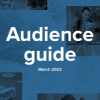Shakespeare North Playhouse: Audience development using Audience Spectrum as a catalyst and tool
Contents
Topics
Victoria Armstrong from Shakespeare North Playhouse outlines how they have been using Audience Spectrum to support their audience development ambitions.
Watch the video summary, or read more below:
The challenge
Shakespeare North Playhouse opened in 2022, and as a very new theatre, we have countless opportunities for audience development in many different directions. However, we know that we can’t tackle everything at once, and to maximise our impact and effectiveness, we will need to focus and align our efforts across the organisation so we’re all working towards the same goals.
What do we want to achieve?
- An agreed direction of travel and shared responsibility for audience development across all departments – including defining the strategy, driving forward an action plan, and holding the whole organisation accountable.
- We want to see a clear correlation between our day-to-day operational actions and our broader impact- specifically finding a way to talk about social impact and our people.
- A shared language about audiences – both for discussions internally and on documents like board reports.
- We also want to ensure we are laying the foundations for becoming a data-led organisation.

What we've been doing
Cross department collaboration
We began by organising an audience development working group, with representation from all departments. The group meets regularly, with meetings scheduled well in advance to ensure they’re given time and space in people’s busy schedules.
Our aim is to:
• Identify the golden thread that connects all our roles and our shared purpose.
• Create space to reflect on our individual roles, why they exist, what drives them, and how they contribute to the bigger picture
• Build a clear understanding of the organisation's vision, mission, and strategic plan and how audience development relates to that.
• Ask the big questions: Why does Shakespeare North exist? Why do our roles matter?
Testing our assumptions
We asked everyone in the working group to choose events that have taken place at Shakespeare North and share their assumptions about who the audience was — and how they know this.
We cross-checked these assumptions against available data, which highlighted where our memories or assumptions might differ from what the data actually shows, helping us build a clearer, more evidence-based understanding.
What data do we have available?
This also prompted us to identify the data tools we currently use, how we use them, and how we could use them more effectively in the future.
We mind-mapped all our current sources of audience data and seeing it laid out like this felt overwhelming! But it also showed just how much raw information we have at our fingertips, even as a midscale organisation without a dedicated insights and data team.
We can draw on sources like our ticketing system (Spektrix), Illuminate (ACE), customer service emails, Google Analytics 4, PointOne, SurveyMonkey…but the real challenge is: what is most useful? How do we visualise it, report on it, and most importantly, turn it, into meaningful actions?
Starting with segmentation
Audience segmentation was an ideal starting point for a room of diverse colleagues. Some of us are driven by data and demographics, while others focus in on the emotions, motivations, and behaviours of an individual. Sometimes many of us are unsure about how data can actually support our work if we don’t work in marketing. Audience segmentation bridges this gap, offering a balanced perspective. It allows us to view individuals beyond just their age or demographics, recognising that (for example) not every 32-year-old is the same. It gives us a shared language that everyone in the room can understand and use to support their work.
Segmentation helps us make sense of the bigger picture, and understand the motivations, behaviours and needs of not only our current audiences, but of the whole population in our community.
We began by looking at the Audience Spectrum profile of our own audiences, in comparison to the local population. This was discussed at a cross-departmental workshop (facilitated by The Audience Agency), where we explored both our core audience segments and those who were prevalent in the local area, but were not so well represented among our audiences.
Understanding that we can’t possibly focus on every segment, we agreed on a handful of key segments which felt appropriate in our context. Together, they represent
- The existing core audience, who we want to continue to serve and develop deeper, loyal relationships with
- The less arts-engaged in our community, who we want to reach as part of our social purpose and mission.
We then began to get to know these segments: their motivations, behaviours, barriers and opportunities and think about how all our various roles across the organisation could respond to the needs of the target segments.
Setting realistic goals and tracking progress
Population segmentation provided the broad overview and context, but now it’s time to define SMART objectives that we can track using the data sources we identified earlier.
It was important to us that these were not all in relation to ticket sales or financial income, our audience objectives are also social, experiential, educational and creative.
We’d track progress against these objectives using:
- Ticketing data e.g., spend, frequency, lead time, ticket type, price type). The Audience Spectrum Enhancement in Spektrix also allows us to report on the Audience Spectrum profile of bookers.
- Audience surveys – for demographic data not collected during the booking process, as well as qualitative feedback.
- Customer care emails
Etc
The future
With a shared understanding of who our core audiences are, who our target under-represented groups are, and some SMART objectives around engaging those segments, we’re now in a strong position to create a robust audience development plan which has support from across the organisation.
We are committed to ensuring this is not a one-off project where the strategy and objectives are simply written up, stored on a shared drive, or left forgotten in a drawer.
Once the SMART objectives are established, the group will continue to meet with a clear purpose—regularly tracking progress, updating objectives as needed, and maintaining a dynamic, responsive strategy and action plan.
This approach will ensure a shared understanding of audience segments across the organisation, making these insights a consistent reference point in board reports and a valuable resource for external funders seeking actionable audience insights.
Interested in what Audience Spectrum can offer your organisation? Contact our team to find out more.
New to Audience Spectrum?
Audience Spectrum is the most powerful segmentation tool for the UK cultural sector
Find out how it can help youCase Studies
-
 Audience Spectrum in Action | Securing Funding for a Circus Festival
Audience Spectrum in Action | Securing Funding for a Circus Festival
-
 Audience Spectrum in Action | Aberdeen Performing Arts
Audience Spectrum in Action | Aberdeen Performing Arts
-
 Audience Spectrum in Action | London & Culture Calling Arts
Audience Spectrum in Action | London & Culture Calling Arts
-
 Audience Spectrum in Action | Theatr Brycheiniog
Audience Spectrum in Action | Theatr Brycheiniog
-
 How Audience Spectrum helped support Nottingham Playhouse's Levelling Up Strategy
How Audience Spectrum helped support Nottingham Playhouse's Levelling Up Strategy
-
 Looking ahead at Hall for Cornwall
Looking ahead at Hall for Cornwall
-
 Using Audience Spectrum to drive culture change and a major audience development programme
Using Audience Spectrum to drive culture change and a major audience development programme
-
 Audience Spectrum in Action | Edinburgh International Festival
Audience Spectrum in Action | Edinburgh International Festival
Related Guides
- Boost Your Email Marketing with Audience Spectrum - a step by step guide
- How to use Audience Spectrum to Enhance your Funding Applications
- How to Use Audience Spectrum to Inform Your Programme and Engage with Diverse Audiences
- How to use Audience Spectrum to Target Paid Online Advertising
- How to use the Audience Spectrum Segments in your Catchment Area chart on your Overview Dashboard
- Segmentation made simple
- Using Audience Spectrum Subsegments | Speak your benefactors' language
- Using Audience Spectrum Subsegments | Upsell your add-ons more effectively
- Top Tips | Using the Audience Spectrum Subsegments
- Using Audience Spectrum Subsegments | Get personal with your profiling
- Using Audience Spectrum Subsegments | Access your underserved audiences
- How understanding audience segmentation can inform your website user experience
- Explanation: Mosaic
- What is the Audience Spectrum Enhancement in Spektrix, and how does it work?
- How to get started with applying Audience Spectrum attributes to your Spektrix reports
- Using Audience Spectrum strategically as a customer attribute in Spektrix
- Creating and improving dynamic content in Spektrix using Audience Spectrum
- Audience Development Planning
- Using evidence for setting audience metrics
- Audience Development Planning - Using Evidence
- 10 Questions to Ask Yourself When Engaging with Communities
- KPIs for audiences: a practical guide
- Creative Activities For Engaging Communities
- Using Your Population Profile Report Plus
- Meaningful mapping
- Top Tips | Getting Started with Audience Development
- An introduction to benchmarking
